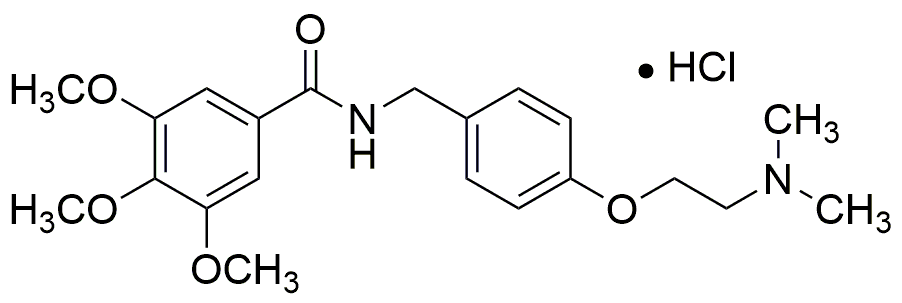Trimethobenzamide hydrochloride is widely utilized in research focused on:
- Antiemetic Treatments: This compound is primarily used to prevent nausea and vomiting, particularly in patients undergoing chemotherapy or surgery. Its effectiveness makes it a go-to option in oncology and post-operative care.
- Pharmaceutical Formulations: It is often incorporated into various pharmaceutical products, enhancing their efficacy in treating gastrointestinal disorders. This application is crucial for pharmaceutical companies aiming to improve patient outcomes.
- Research on Drug Interactions: Researchers utilize this compound to study its interactions with other medications, helping to identify potential side effects and optimize treatment regimens in clinical settings.
- Veterinary Medicine: Trimethobenzamide hydrochloride is also applied in veterinary practices to manage nausea in animals, showcasing its versatility across different fields of medicine.
- Formulation of Injectable Solutions: Its solubility properties make it suitable for developing injectable formulations, which are essential in emergency medicine and for patients who cannot take oral medications.
General Information
Properties
Safety and Regulations
Applications
Trimethobenzamide hydrochloride is widely utilized in research focused on:
- Antiemetic Treatments: This compound is primarily used to prevent nausea and vomiting, particularly in patients undergoing chemotherapy or surgery. Its effectiveness makes it a go-to option in oncology and post-operative care.
- Pharmaceutical Formulations: It is often incorporated into various pharmaceutical products, enhancing their efficacy in treating gastrointestinal disorders. This application is crucial for pharmaceutical companies aiming to improve patient outcomes.
- Research on Drug Interactions: Researchers utilize this compound to study its interactions with other medications, helping to identify potential side effects and optimize treatment regimens in clinical settings.
- Veterinary Medicine: Trimethobenzamide hydrochloride is also applied in veterinary practices to manage nausea in animals, showcasing its versatility across different fields of medicine.
- Formulation of Injectable Solutions: Its solubility properties make it suitable for developing injectable formulations, which are essential in emergency medicine and for patients who cannot take oral medications.
Documents
Safety Data Sheets (SDS)
The SDS provides comprehensive safety information on handling, storage, and disposal of the product.
Product Specification (PS)
The PS provides a comprehensive breakdown of the product’s properties, including chemical composition, physical state, purity, and storage requirements. It also details acceptable quality ranges and the product's intended applications.
Certificates of Analysis (COA)
Search for Certificates of Analysis (COA) by entering the products Lot Number. Lot and Batch Numbers can be found on a product’s label following the words ‘Lot’ or ‘Batch’.
*Catalog Number
*Lot Number
Certificates Of Origin (COO)
This COO confirms the country where the product was manufactured, and also details the materials and components used in it and whether it is derived from natural, synthetic, or other specific sources. This certificate may be required for customs, trade, and regulatory compliance.
*Catalog Number
*Lot Number
Safety Data Sheets (SDS)
The SDS provides comprehensive safety information on handling, storage, and disposal of the product.
DownloadProduct Specification (PS)
The PS provides a comprehensive breakdown of the product’s properties, including chemical composition, physical state, purity, and storage requirements. It also details acceptable quality ranges and the product's intended applications.
DownloadCertificates of Analysis (COA)
Search for Certificates of Analysis (COA) by entering the products Lot Number. Lot and Batch Numbers can be found on a product’s label following the words ‘Lot’ or ‘Batch’.
*Catalog Number
*Lot Number
Certificates Of Origin (COO)
This COO confirms the country where the product was manufactured, and also details the materials and components used in it and whether it is derived from natural, synthetic, or other specific sources. This certificate may be required for customs, trade, and regulatory compliance.

